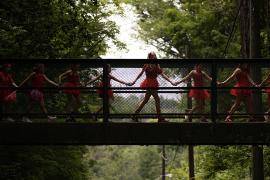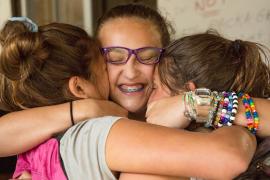Welcome to camp! Whether you are a resident or day camp counselor this summer, you will soon find yourself working with a variety of camper groups. These groups will most likely consist of kids of similar age, gender, or activity interest who randomly come to camp for the same period of time. Each group will remain just that — a group — unless some magic occurs and you do your part to guide them on their journey to evolve into a community.
So, what’s the difference? According to Merriam Webster, a group is “a number of people who are together in the same place.” This could be all of the eight-year-old boys attending the first two-week session of the season are assigned to the same cabin, or the girls who are beginners in tennis are put together in third period tennis class. A community, however, is “a unified body of individuals.” The key word here is unified. As much as you would like to wave a magic wand and have your camper group develop into a community of “BFFs” by closing day, it doesn’t quite happen that way.
While there is work on your part to ensure that each camper group progresses to a community, it is not an unsolved mystery as to how to make it happen. The secret to cultivating this progression in any camper group starts with an understanding of the stages of group development. Through activity resources given here and others learned during staff training, you will have some tools to intentionally foster growth at each stage. These activities will equip you to help campers make introductions and connections, establish positive group norms, create a framework for communication, and provide opportunities for teamwork and trust with each camper group.
“Slinky-Smurf” (Frank, 2001), one of my all-time favorite large-group games, is a great model for learning the stages of group development. It is also a fun icebreaker to play with campers. There are two parts to this game, the first being rock/paper/scissors (RPS). Even though RPS is typically a universal game, it is a good idea to review this with the campers to be sure everyone knows how to play.
After everyone has brushed up on RPS, teach the five levels of the “Slinky-Smurf” game in the following order and the motions that go along with each.
- Slinky: Move both hands as if toggling a slinky back and forth between them.
- Super Ball: Bounce up and down in place.
- Silly Putty: Use your fingers to knead your cheeks on both sides of your face.
- Cheerleader: Do spirit fingers above your head and point one foot forward.
- Happy Smurf: Sing the Smurf song (la, la, la-la-la, la-la-la).
I recommend practicing the five levels a few times before bringing the two parts of the game together.
To merge RPS and the Slinky-Smurf levels into one game, each person begins as a Slinky and plays RPS with a partner until there is a champion. Whoever wins RPS morphs into a Super Ball while the other player stays at the Slinky level and finds another Slinky to challenge in RPS. The new Super Ball finds another Super Ball and does RPS. The winner morphs into Silly Putty while the other one morphs back into a Slinky. Players always engage in RPS with someone at the same level; the winner moves up to the next level, while the other person goes back down a level (unless a Slinky, then you remain a Slinky). Once players reach the Happy Smurf level, they locate the other Happy Smurfs and enthusiastically sing the Smurf song until the game comes to an end (usually after several minutes).
Just like there is a definite start and finish to the Slinky-Smurf game, there is a distinct beginning and end when groups come together at camp. What happens in the middle with various groups resembles the forward and backward progression of levels in the Slinky-Smurf game. The interesting thing, though, is that every group advances through predictable stages of development from inception to culmination. You can help camper groups progress from one stage to the next by recognizing where each group is in their development and intentionally selecting activities that are appropriate for each level.
Coming Together Is a Beginning
Similar to a Slinky, campers are flexible, yet hesitant or anxious when they first arrive. The initial few days for all groups are a time for campers to get to know one another and adjust to their summer home. Both returning and new campers are eager to see what camp is about, to make friends, and to fit in. There is typically automatic acceptance into the group at first as campers in the Slinky stage are fairly tolerant of one another. It is important for you to help campers make introductions and find connections with others in a nonthreatening way. Name games, icebreakers, and other get-to-know-you activities that help campers discover commonalities with each other are appropriate to use until your group is ready to share at a deeper level.
You may find campers prefer to stick with what is comfortable and familiar to them during the Slinky stage when choosing activities or getting involved in the camp program. This is perfectly OK. They will have the opportunity to branch out more as the session unfolds and their comfort and confidence levels increase. The start of each camp session is your golden opportunity to set expectations and establish routines for your group meetings and discussions that will be the building blocks for future work and play together. The fun of camp is just beginning!
Keeping Together Is Progress
Once the foundation is in place, campers are ready to take off. Like a Super Ball, campers at this stage have a lot of energy and will be eager to do something with it. You will often find they want to explore and try new things. Campers may be ready to go beyond the surface and share on a more meaningful level. You should provide activities for them that will allow them to do this in a safe way. Establish guidelines for these activities so that all have a chance to participate equally and fairly. It is also crucial to work on improving communication skills, especially sharing and listening, so the group is able to have a peaceful discussion when things aren’t going so well and to work through issues as they arise.
There are bound to be disagreements and conflicts in any group — especially if they are together for an extended period of time. Just like Silly Putty, your group may be pulling in all different directions. This is normal and to be expected. During this stage, campers must work for acceptance in the group; they may even test expectations to see if you will follow through as promised in the beginning. No matter how tempting it is to deviate from your original plan when being tested, stick to your established routines to provide safety and comfort for the campers. They will respect and trust you even more because of it.
The key to moving on from this stage is to give campers the support they need to work through any issues they may be having. Do not ignore what is happening and hope it will go away. Activities that help campers learn how to work together toward a common goal and encourage the acceptance of individual differences while recognizing the strengths of others are paramount to making forward progress. Camp is even more fun once you get through the Silly Putty stage.
Staying Together Is Success
Once your group has experienced the success of moving past challenging times and is working well together, now is the time to enjoy their cohesiveness. Cheerleaders must communicate well, work as a team, and trust each other to accomplish complex stunts; this is also true of your campers at this stage. Take advantage of the ability your “cheerleaders” now have to work well with one another by planning some special time to be together. A new adventure or outing could be the ticket for having the most fun ever.
As a camp session nears its end, you will notice that campers can’t help but to flourish because of their individual and group successes along the way. They will exhibit confidence and independence and stand taller than they did at the beginning of their camp experience. (Look at camper photos at the beginning and end of a session — the change can be remarkable!) Acceptance in the group has now been earned and friends are more like family. Campers are comfortable with expectations at this point and it is good to change up routines to provide variety and new opportunities for them to succeed.
The best of each camper has now combined to form a strong team, and it can be difficult for them to go their separate ways after taking this journey together. You may observe how strong those bonds can be, especially when campers come for longer sessions, because of the growth that is made after reaching the other side of struggles and conflicts. Spend time helping campers put closure on their camp experience by allowing them to reminisce and say good-bye. Your hard work and intentionality has fostered the evolution of a group of campers — now Happy Smurfs — into a unified community. It is time to celebrate! “La, la, la-la-la, la-la-la . . .”
For camps that have multiple sessions each summer, you will most likely greet a new group of campers every week or two. Even though it will feel like you are personally in the Happy Smurf stage after each group leaves, you will need to start the Slinky-Smurf process all over again with each new crew of campers. Every group is unique in their own way, but they will predictably flow through the stages of group development until they, too, are a community.
Additionally, know that any time a camper joins or leaves your group you will experience a change in the overall dynamics. You will need to adjust accordingly, depending on where your campers are in the stages of group development. The possibility also exists for a group to get stuck in a particular stage or to digress to a previous stage. Patience and persistence are key to continued forward progress.
Activity Ideas for Each Stage of Group Development
|
Discussion Questions:
|
Photos courtesy of Camp Westwind, Otis, Oregon
References:
Frank, L. (2001) The caring classroom: Using adventure to create community in the classroom and beyond. Hamilton, MA: Project Adventure, Inc.
Sandborn, J. (1994). Bag of tricks II: More great games for children of all ages. Florissant, CO: Search Publications.
Schoel, J. & Stratton, M., eds. (1990). Gold nuggets: Readings for experiential education. Hamilton, MA: Project Adventure, Inc.
Weinstein, M. & Goodman, J. (1980). Everybody’s guide to non-competitive play: Playfair. Atascadero, CA: Impact Publishers.
Kim Aycock, MST, has more than 30 years of experience blending the skills of a master teacher with the knowledge of a seasoned camp expert. She trains camp staff at all levels and speaks professionally at regional and national conferences. More information can be found on her website: kimaycock.com. Kim may be contacted at kimdaycock@gmail.com.



